It’s a rite of passage for all social media platforms: the scrutiny that comes with increasing size, power and revenue. National and supranational bodies in the US, the EU and others are constantly probing Meta and Google, handing out fines before apparently starting the process all over again. But the scrutiny that TikTok is seemingly more serious. Thanks to its Chinese ownership and concerns around whether the Chinese government has access to TikTok user data, the social platform has already been completely banned in India, and the governments of the US, the UK, Belgium and Australia have banned staff from using it on work devices – as have the three main institutions of the EU. Some countries including, crucially, the US, are considering a total ban. This would have significant ramifications for the ad industry and for marketers who rely on access to TikTok’s passionate, engaged, Gen Z audience.
TikTok is big – and it’s getting bigger
TikTok is a major player in the digital ad industry globally and particularly in the US. In 2022, its share of US digital ad spend – 2.4% – was comparable with YouTube’s. That share is expected to grow to 3.1% in 2023 and 3.5% in 2024. Its net ad revenues could double in two years, to $11bn in 2024. Three in four US advertisers expect to increase their spend on TikTok in the next year. There’s no denying TikTok’s growth is impressive. It has surpassed Twitter and Snapchat, but it isn’t even in the same ballpark as Google and Meta. However, what it does have over these two tech titans is cultural cachet. That’s what makes it so exciting and so important for advertisers.
Should advertisers continue to invest in TikTok?
As suspicion of TikTok increases, particularly in the West, advertisers will need to consider if it’s worth the risk to their brand safety. Even if there isn’t a ban in the US or other major countries, advertisers will need to monitor the situation. Theoretically, negative rhetoric alone could translate into a drop in the number of users. There’s also a possibility that the US administration will stop short of a ban, but will pressurize advertisers to divert their ad dollars, in a similar way in which brands adhered to the trade embargo on Russia after the latter invaded Ukraine in 2022.
However, there is one crucial factor to consider; how much TikTok users love TikTok, especially Gen Z. 45 million American Gen-Z-ers use TikTok, and it’s their most-visited site. They will not give it up easily, doubtless claiming that a ban would violate their right to freedom of expression. For that reason, it’s safe for brands to continue investing in the platform, at least for the time being. Just look at the #StopHateforProfit Facebook boycott – when things had quietened down, brands re-instated their spend on the platform, without any backlash, because people still wanted to use Facebook.
What are the alternatives to TikTok?
But even if it is safe for brands to continue investing their ad dollars in TikTok, it’s wise not to rely solely on one platform – even less so when its future is in question. So where else can marketers reach the lucrative Gen Z audience?
These younger audiences love TikTok – there’s no doubt about it. But it’s not the only digital platform they use, and short-form video isn’t the only media they consume. Advertisers don’t have to invest in like-for-like media to reach them. If TikTok is banned, the war for attention – both from consumers and advertisers – will be intense. That’s especially the case for Instagram and YouTube, who have developed copycat products (Reels and Shorts respectively) with the sole aim of replicating TikTok’s success. These products also have the advantage of more capabilities such as retargeting. Instagram’s parent company Meta will be rubbing its hands in anticipation. It was only last year that it paid a consulting firm to create a US-wide campaign to turn the public against TikTok.
Snapchat, the other ‘challenger’ social media network, will also be hoping to seize the opportunity. There may even be new players rushing to fill the vacuum left by TikTok by creating a platform that mimics the Chinese app’s virality and rapid rise in popularity.
But there are alternative approaches to simply reallocating budget that was previously invested in TikTok. Investing in a diverse range of channels that align with a brand’s marketing goals helps build resilience. This is especially true given that Gen Z is as diverse as any other generation and not 100% obsessed with TikTok and short-form video. It is also worth taking the opportunity to build up first-party data, with the death of the cookie approaching quickly and regulators closing in on Big Tech. This isn’t straightforward, but the long-term gain would be significant.
An uncertain future for TikTok and the advertisers who love it
No one knows whether TikTok will be banned outright in the US. It’s working hard to highlight its contribution to the US economy, to culture and to the success of US businesses. It’s also created a $1.5 billion initiative called Project Texas, which will ensure that American data is stored on ‘American soil by an American company overseen by American personnel’. The idea is to give the US government confidence that their Chinese counterparts cannot access US user data.
There’s also likely some reluctance among the Biden administration and the wider Democratic party to ban TikTok. After all, Gen Z is a key demographic for them in the upcoming Presidential election. Banning TikTok would ostracize them and remove an excellent means to engage with them.
If TikTok is banned, however, there are plenty of competitors who will happily absorb any ‘spare’ ad dollars. In any case, whether it is banned or not, it would be wise to diversify – into other social platforms, yes, but also into strategies that build first-party data and make brands less reliant on the Big Tech walled gardens. The scrutiny that TikTok is under could be a sign that how all the Big Tech firms collect and use data could come under the cosh. Being less dependent on them can only be a good thing.




.png)




